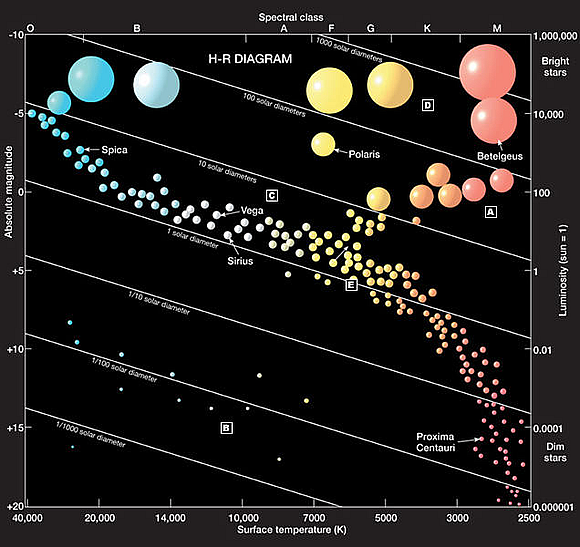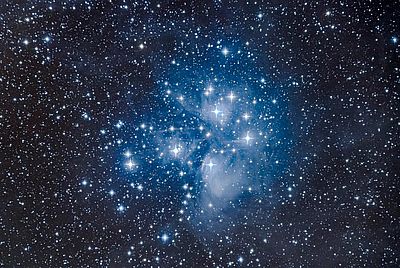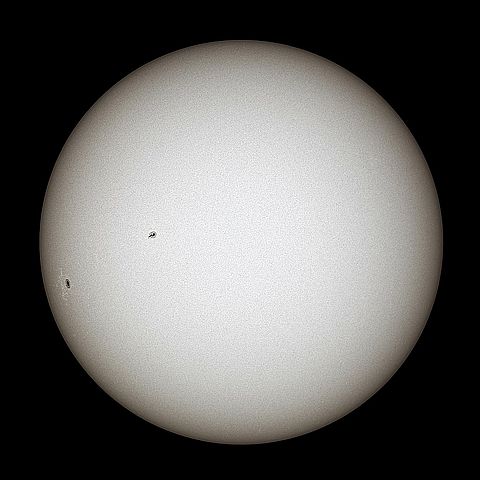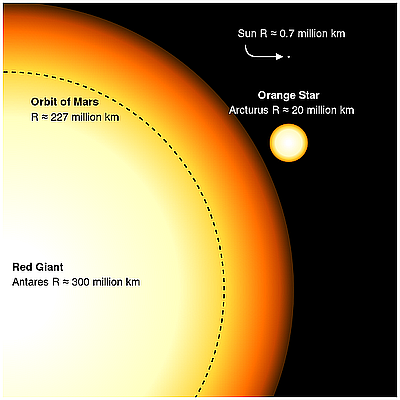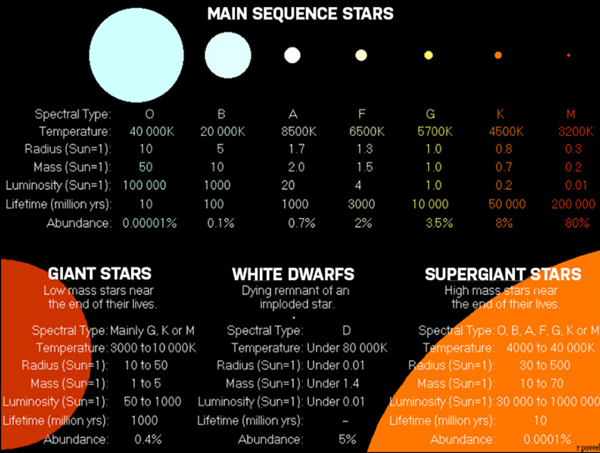Look closely at stars in the night sky with the naked eye and you may notice they are not all the same colour. Most appear just white, but some are noticeably blue-white, whilst others shine with an orange lustre. Use optical aid and you will observe a whole host of subtle hues in between. A star’s colour is fundamentally controlled by its temperature, the hotter a star is, the bluer it appears, whereas cooler stars glow orange or even red. If you imagine metal being heated up to high temperatures, it will initially glow red, then yellow and white and eventually will be hot enough to glow a bright blue colour.

Coolest stars to the right - hottest to the left.
During the early and middle part of the 20th century, astronomers built upon the foundations of using simple temperature based spectral class analysis used at the end of the 19th century, to arrive at the more complex stellar classification system used today. By understanding how varied parameters, including stellar mass, density, luminosity, size, and age all impact on stellar classification, has helped define our view of stellar evolution.
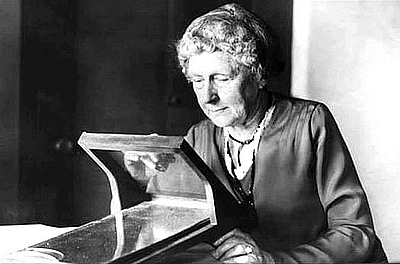
Annie Cannon Jump - architect of the
Harvard stellar Classification Scheme
Stellar classification was initially laid down in the late 19th century, but it wasn't until the turn of the 20th century that the Harvard Classification Scheme was drawn up by astronomer Annie Jump Cannon. In 1896 she became a member of the 'Harvard Computers', a group of women hired by Harvard Observatory director Edward C Pickering to complete the Henry Draper Catalogue - mapping and defining every star in the sky to a photographic mag of +9. Cannon re-ordered and simplified the prior alphabetical system by Draper.
The Harvard system of stellar classification is a one-dimensional system in which the stars are classified into 7 main categories according to their spectrum. This classification is based on the surface temperature of the star and was first demonstrated as such by Harvard astronomer Cecilia Payne. The spectral sequence is O-B-A-F-G-K-M and runs from hottest, to coolest stars, with an O type star having a surface temperature of about 50,000 K and an M type star having one of just 2,500 K.
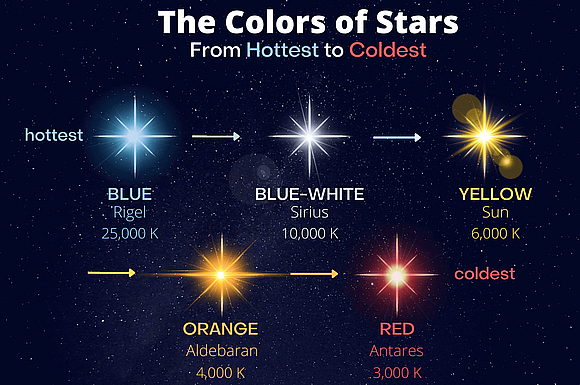 Our closest star, the Sun, shines with a yellow light and is classed as a 'G' star, with a temperature of about 5,800°K. (The base unit 'Kelvin' - 5,800°K equates to about 5,530°C). Hotter stars are far less common than cooler, orange ones. For example, 'O' type stars make up only 1 in every 3 million stars visible. The next hottest, 'B' stars are more numerous, making up 1 in 800 stars, whilst A type stars are more numerous still. Each cooler sub-type become more and more common. The coolest 'M' type stars make up 75% of all stars, though the majority of these are invisible to the naked eye and are red dwarf stars.
Our closest star, the Sun, shines with a yellow light and is classed as a 'G' star, with a temperature of about 5,800°K. (The base unit 'Kelvin' - 5,800°K equates to about 5,530°C). Hotter stars are far less common than cooler, orange ones. For example, 'O' type stars make up only 1 in every 3 million stars visible. The next hottest, 'B' stars are more numerous, making up 1 in 800 stars, whilst A type stars are more numerous still. Each cooler sub-type become more and more common. The coolest 'M' type stars make up 75% of all stars, though the majority of these are invisible to the naked eye and are red dwarf stars.
Spectral sub-classes are also further subdivided and numbered 0 - 9, with 0 being hotter than 1. For example, the Sun is a G2 star which is hotter than a G7 star, but cooler than a G0 star. Similarly, an A9 star is cooler than a A4 star, but hotter than an F1 star. One easy way to learn the order is by associating a word of a sentence to each alphabet letter. Such as, Oh Boy, A Funny Girl/Guy Kicked Me, or, Wow Oh Be A Fine Girl/Guy Kiss Me
Listed below are the stellar classes and approximate temperature ranges.
- W: >100,000 K
- O: 30,000+k
- B: 10,000–30,000 K
- A: 7,500–10,000 K
- F: 6,000–7,500 K
- G: 5,200–6,000 K
- K: 3,700-5200 K
- M: 2,400–3,700 K
By convention, colour descriptions represent those relative to the colour of an A-class star, (considered to be white). However, only the brighter stars in the sky exhibit any colour, the rest are too dim for colour vision to work without augmentation.
Stars come in all sizes and different stages of evolution, and just assigning an alphabet letter to each star according to its surface temperature isn’t enough for stellar classification. There are the main sequence stars still converting hydrogen into helium in their core (Sun) and there are also white dwarfs that have ended their lives. So, we need another parameter to differentiate them, Luminosity.
Luminosity, in astrophysics relates to the total energy output per unit of time. More dense stars with higher surface gravity exhibit greater pressure broadening of spectral lines. The gravity, and hence the pressure, on the surface of a giant star, is much lower than for a dwarf star because the radius of the giant is much greater than a dwarf of similar mass. Differences in the spectrum can therefore be interpreted as 'luminosity effects' and a luminosity class can be assigned purely from an examination of the spectrum.
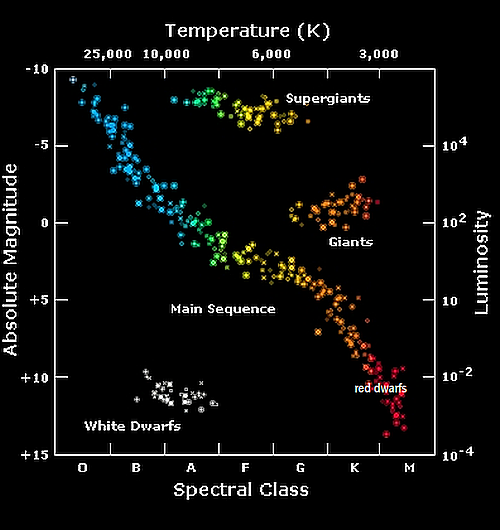
M -type red super-giants, red giants and red dwarfs all have similar temperatures,
...but vastly different luminosities.
The Luminosity class and its description is as follows:
- 0 or Ia(+): hypergiants or extremely bright supergiants
- Ia: luminous supergiants
- Iab: intermediate-size luminous supergiants
- Ib: less luminous supergiants
- II: bright giants
- III: normal giants
- IV: subgiants
- V: main sequence
- sd: sub-dwarfs
- D: white dwarfs
Finally, when the Harvard system and the Yerkes luminosity classes are combined, we get the current Morgan Keenan (MK) stellar classification system introduced in 1943 by William Wilson Morgan, Philip Keenan and Edith Kellman from Yerkes Observatory and remains in use today. This is a two-dimensional (temperature and luminosity) classification scheme based on spectral lines sensitive to stellar temperature and a luminosity class corresponding to its surface gravity. Our Sun is therefore classed with a surface temperature of about 5,800 K (a G2 type) and is also fusing hydrogen into helium in its core, a main-sequence (V) star - G2V. The MK system really comes into play while plotting all stars on just one diagram, the famous Hertzsprung-Russell diagram.
Class Types -examples
Class W: Wolf–Rayet
Once included as type O stars, Wolf-Rayet stars of class W or WR are notable for spectra lacking hydrogen lines. Instead their spectra are dominated by broad emission lines of highly ionized helium, nitrogen, carbon, and sometimes oxygen. They are thought to be the exposed hot helium shells mostly dying supergiant stars where stellar winds have blown away their outer hydrogen layers. Class W is further divided into subclasses according to the relative strength of nitrogen and carbon emission lines in their spectra (and outer layers)
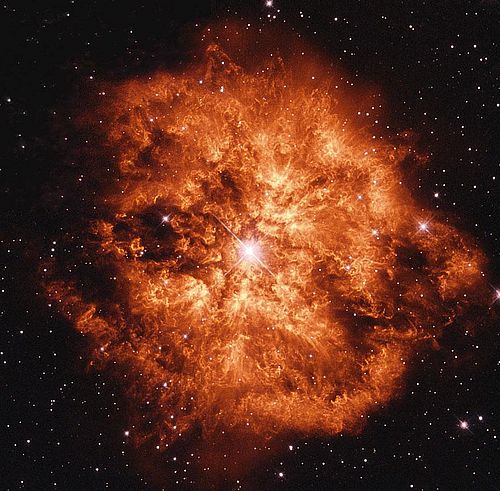
Wolf-Rayet star WR 124 and surrounding nebula known as M1-67 in Sagitta
Class O
O-type stars are very hot and extremely luminous, with most of their radiated output in the UV range. These are the rarest main-sequence stars accounting for just 1 in 3,000,000 (0.00003%) main-sequence stars including some of the most massive stars known. O-type stars frequently have complicated surroundings that make measurement of their spectra difficult. O-type stars have dominant lines of absorption and sometimes emission for Helium II lines and prominent hydrogen lines. Higher-mass O-type stars do not retain extensive atmospheres due to the extreme velocity of their stellar winds, which may reach 2,000 km/s. Because they are so massive, O-type stars have very hot cores and burn through their hydrogen fuel very quickly, being the first stars to evolve off the main sequence.
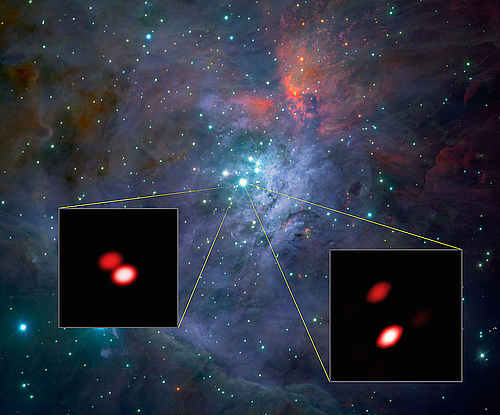
Theta C1 in the Trapezium cluster in the Orion nebula M42
Spectral standard examples
- O7V – S Monocerotis
- O9V - 10 Lcerertae.
- Sigma Orionis
- AE Aurigae
- Theta (C1) Orionis - trapezium.
Class B
B-type stars are very luminous and blue. Their spectra have neutral helium lines, which are most prominent at the B2 subclass, and moderate hydrogen lines. As O - and B type stars are so energetic, they only live for a relatively short time and tend not to stray far from the area in which they formed due to low kinematic interaction during their lifetime, apart from Runaway stars. Main sequence B class stars are defined by the intensity of the He I violet spectrum, with lines of silicon visible for supergiants. These stars tend to be found in their originating OB associations, found in giant molecular clouds such as the Orion OB1 association. This occupies a large portion of the local Orion spiral arm in Milky Way and contains many of the brighter stars in the constellation of Orion. B- type stars are relatively uncommon, around 1 in 800 (0.125%) of the main-sequence stars in the solar neighborhood are B class stars, the closest being Regulus, approx 80 light years.
Massive, non supergiant stars known as Be stars are of particular interest, thought to feature unusually strong stellar winds, high surface temperatures, and loss of stellar mass as the objects rotate a curiously rapid rates. They possess distinctive neutral or low ionisation emission lines considered to have forbidden mechanisms not normally allowed under our current understandings of quantum mechanics.
Spectral standards: examples
- B0V – Upsilon Orionis
- B0Ia – Alnilam
- B2Ib – 9 Cephei
- B3V – Eta Ursae Majoris.
- B3V – Eta Aurigaee
- B5Ia – Eta Canis Majoris
- B8Ia – Rigel
Class A
A-type stars are among the more common naked eye stars, and are white or bluish-white. They have strong hydrogen lines, at a maximum by A0, and also lines of ionized metals (Fe II, Mg II, Si II) at a maximum at A5. At this point the presence of Calcium II is notably strengthening. Around 1 in 160 (0.625%) of the main-sequence stars in the solar neighborhood are A-type stars, including 9 stars within 50 light years.

A- Type - Vega in Lyra
Spectral standards: examples
- A0Va – Vega
- A0Ib – Eta Leonis
- A1V – Sirius A
- A2Ia – Deneb
- A3Va – Fomalhaut.
Class F
F-type stars are characterized by the weaker hydrogen lines and ionized metals, neutral metals (Fe I, Cr I) but have strengthening spectral lines of Ca II. Their color is white - or subtle apple white. About 1 in 33 (3.03%) of the main-sequence stars in the solar neighborhood are F-type stars, including 12 stars within 40 light years.
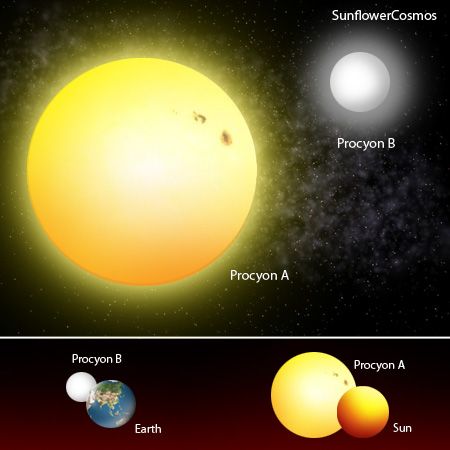
Spectral standards:
- F0IIIa – Zeta Leonis
- F0Ib – Alpha Leporis
- F2V – 78 Ursae Majoris
- F5 IV-V - Procyon
Class G
G-type stars, including our Sun, have prominent spectral lines of Ca II, which are most pronounced at G2. They have even weaker hydrogen lines than type F, but along with the ionized metals, they have neutral metals. Class G main-sequence stars account for almost one in thirteen (7.5%) of main-sequence stars in the solar neighborhood. There are around 21 G-type stars within 40 light years.
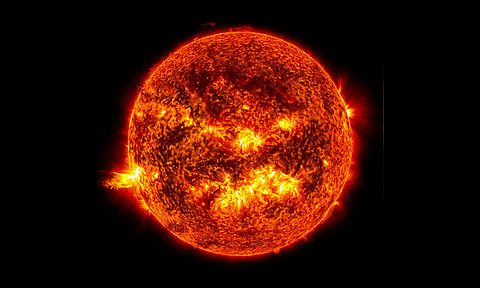
Our Sun laid bare - showing cells, flares and prominences.
Spectral standards:
- G0V – Beta Canum Venaticorum
- G0IV – Eta Bootis
- G0Ib – Beta Aquarii
- G1III - Capella
- G2V – The Sun
- G5Ib – 9 Pegasi
- G8IV – Bta Aquilae
- G8Ib – Epsilon Geminorium
Class K
K-type stars have extremely weak hydrogen lines, if present at all, and mostly neutral metals (Mn I, Fe I, Si I). By late type K, molecular bands of Titanium Oxide become more prominant K type stars appear quite orange, slightly cooler than the Sun. They make up about 12% of the main-sequence stars in the solar neighborhood, but there are also giant K-type stars, which range from hypergiants such as RW Cephei, giants and supergiants, such as Arcturus. Orange dwarfs, like Alpha Centauri B are main-sequence stars. Low stellar radiation and star longevity would suggest such stars have the optimal chances of evolved life developing on orbiting planets, having a broader habitable zone for planetary orbits.
Spectral standards:
- K0III – Pollux
- K1.5III - Arcturus
- K2V – Epsilon Eridani
- K3III – Rho Bootis
- K5V – 61 Cygni A
- K5III – Aldebaran
Class M
Class M stars are by far the most common. About 76% of the main-sequence stars in the solar neighbourhood are class M stars. However, many class M main-sequence stars (red dwarfs) have such low luminosities that none are bright enough to be seen with the unaided eye. Although most class M stars are red dwarfs, most of the largest-known supergiant stars in the Milky Way are class M stars, such as VV Cephei, Antares, and Betelgeuse. The spectrum of a class M star contains lines from oxide molecules (especially Ti0) and all neutral metals, but absorption lines of hydrogen are usually absent. TiO bands can be strong in class M stars, dominant by about M5.
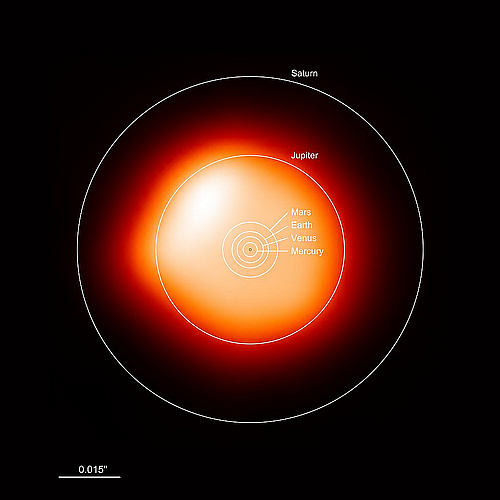
Betelguese in Orion - an M type red super-giant.
Spectral standards:
- M0IIIa – Beta Andromedae
- M1.5Iab - Antares
- M2III – Chi Pegasi
- M1-M2Ia-Iab – Betelgeuse
- M2Ia – Mu Cephei - the garnet star
Armed with a star's class details - via printed format or media, it is most rewarding for the amateur astronomer to recognise exactly what type of star they are observing, be it well known, or just another face in the stellar crowd.
- Log in to post comments


